Hallo...Hallo...Hört jemand zu???
Let's get to know a little about a brave 6x4 vehicle manufactured by Krupp in the mid-30s, which can almost be considered a symbol of German mechanized forces in WWII. The subject of the article is the L2 H143 Krupp Protze, a vehicle that was designed as an artillery tractor and, thanks to its versatility and robustness, was adapted for numerous tasks.
Today we are going to talk about one of its versions, the radio communication version: with you, the Krupp Protze L2 H143 Funkkraftwagen (Radio-car) - Kfz. 19
 |
| Krupp Protze L2 H143 Funkkraftwagen (Radio-car) - Kfz. 19 resting near woods. Notice oil can and jerry-can, attached to the cage antenna, in the roof. |
History:
We can trace the name Krupp back to the year 1587 in Essen, Germany. Krupp's steelmaking tradition began in 1799, with the acquisition of a mill called Gute Hoffnung (Good Hope) mill, and later, the construction of a steel foundry factory, founded in 1811.
Krupp's most important invention in those early days was in 1853: a seamless, highly resistant railroad-wheel. This wheel became the emblem of the company, three joined rings, in 1875.
 |
| "On good cars this brand" 30's Krupp radiator cap emblem |
Despite frequent financial crises in Europe, in the turbulent years of the late 19th century, the company steadily expanded and strengthened. With the advent of World War I, Krupp production was almost exclusively converted to the war effort, especially in the manufacture of weapons and ammunition.
 |
made by Krupp - Germany - WW I |
After the Treaty of Versailles, Krupp was forced to change to the production of other products (special steels, locomotives, farm machinery, public works vehicles, engines (for trucks), etc. The "Truck Factory Department" went into business in 1919. The first model made in large numbers was the "Five-ton with 75 HP 4-cylinder Otto Engine" of 1920.
With the end of the WWI and the signing of the Treaty of Versailles, Krupp had to shift its production to other products, such as special steels, locomotives, agricultural machinery, public works vehicles, truck engines, etc. The first truck model produced in large numbers was the "Otto 4-cylinder, 5-ton engine with 75 HP" of 1920.
 |
| Krupp semi-tractor truck - 1920. |
In 1924, 1.5, 2.5 and 3-ton high-speed trucks appeared. In 1925 a modified 5-ton truck was launched. The first low chassis buses appeared in 1928. Until the Second World War, Krupp offered a wide variety of trucks with different chassis heights (H, M, N), engines (petrol, diesel, wood gas) and load capacities ( 1.5, 2, 2.5, 3, 3.5, 4, 5, 5.5, 6.5 tons).
Krupp carried out pioneering work in the construction of truck engines, through the development of high-performance carburetors for gasoline engines and air-cooled diesel engines. In 1937 the number of vehicles produced totaled 4.300, made by a workforce of 2.685 employees.
In 1939, official Nazi Party requirements limited the production of civilian vehicles to 3-tonne and 6.5-ton trucks. In 1940, Krupp was obliged to build 12-ton heavy half-track tractors, the Sonderkraftfahrzeug 8 ("special motorized vehicle 8"), usually abbreviated to Sd.Kfz. 8, under license.
%20Half-Track%20Artillery%20Tractor.jpg) |
| Sd.Kfz.8 (DB9) Half-Track Artillery Tractor Trumpeter kit (#09538) box art |
In 1941 only truck engines, the Krupp Protze L2 H143 and Sd.Kfz.8 vehicles were in production. In 1942, the production of Krupp Protz, almost 200 a month, was stopped. That year, 3.403 employees were on the payroll. The first heavy air raids on Essen and the factory took place from March 1943. By the end of the war, 70% of the company's facilities had been destroyed or damaged.
 |
| Krupp AG works at Essen, Germany, seriously damaged by Bomber Command in 1943 and further wrecked in the daylight raid of 11 March 1945. |
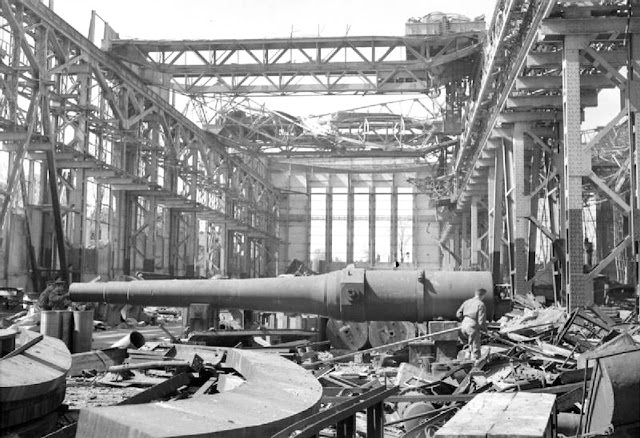 |
| RAF officers inspect an unfinished siege gun in a wrecked building of the Krupp AG plant at Essen, Germany - 1945 Essen was principal target for Bomber Command throughout the war. |
The Krupp ProtzeL2 H43 and L2 H143:
The Geländewagen (all-terrain vehicle) Krupp Protze (officially L2 H43 and L2 H143) was a six-wheeled 6x4 German truck and artillery tractor produced between 1934 and 1936 (L2 H43) and 1937 to 1941 in L2 H143 version.
 |
| Geländewagen Krupp Protze L2 H143 chassis left view |
 |
| Geländewagen Krupp Protze L2 H143 chassis rear view |
The truck weighed 2.5 tons and was powered by a 55 hp (L2 H43) or 60 hp (L2 H143) Krupp Boxer 3.3 litre engine. The road range was 450 kilometers and had a payload capacity of 1 ton. The Krupp Protze was admired for its good performance both on and off road. The L2.H143 model (1937) was slightly longer (150 mm), was powered by a 60 hp engine and presented a longer front bumper.
Krupp truck type designations are confusing at first, but they contain a lot of information. For example, "L2 H143" means:
L = Lastwagen (truck)
2 = load capacity in tonnes
H = light frame
1 = first modification
4 = 4 cylinders
3 = three axles
 |
| L2 H43 Krupp Protze 6x4 Geländewagen (early) |
 |
| L2 H143 Krupp Protze 6x4 Geländewagen (late) |
It was powered by a 4-cylinder, 55 hp or, from 1936, 60 hp Krupp M 304 petrol engine. Its main purpose was to tow artillery, especially the 3.7 cm Pak 36 anti-tank gun (designated Kfz 69), and transport motorized infantry (designated Kfz 70), in the early years of WWII.
This vehicle was extensively used on the Eastern Front, during the North African campaign and in France and Sicily. The "Krupp-Protze" was of relatively advanced design. Its fuel consumption was relatively high (24 Litres / 100 km on road) in comparison to the comparable Opel Blitz 1.5 t truck (16.5 liters / 100 km, produced 1938 - 1942).
 |
| Krupp Protze Protzkraftwagen - Kfz.69 under engine maintenance |
Variants:
- Kfz.19 - Fernsprechbetriebskraftwagen
- Kfz.19 - Funkkraftwagen
- telephone operating car
- radio car
 |
| Krupp Protze L2 H143 Fernsprechbetriebskraftwagen (telephone-car) - Kfz. 19 being transported in a rail-car |
 |
| Krupp Protze Funkkraftwagen (radio car) - Kfz.19 passing by a Horch Kfz.15 |
- Kfz.21 - schwerer geländegängiger Personenkraftwagen (6-sitzig)
- staff car (proposed, not adopted)
- heavy cross-country passenger car (6-seated)
 |
| Krupp Protze schwerer geländegängiger Personenkraftwagen (staff-car) - Kfz.21 |
- Kfz.68 - Funkmastkraftwagen
- radio mast carrier
 |
| The Krupp Protze Funkmastkraftwagen (radio mast car) - Kfz.68 with his mast lying on the roof of the vehicle |
 |
| Krupp Protze Funkmastkraftwagen (radio mast car) - Kfz.68 Notice the soldiers preparing the radio mast |
 |
| Krupp Protze Funkmastkraftwagen (radio mast car) - Kfz.68 Now, the soldiers are erecting the radio mast with his cables. |
- Kfz.69 - Protzkraftwagen
- standard configuration for towing the 3.7 cm Pak 36 anti-tank gun.
- limber motor vehicle (other guns)
- portée with 3,7 cm PaK 36 AT gun
- armoured portée 3,7 cm PaK 36 AT gun (field adaptation)
 |
| Krupp Protze Protzkraftwagen (artillery tractor) - Kfz.69 towing a 3.7 cm Pak 36 anti-tank gun over a railroad |
 |
| Another Krupp Protze Protzkraftwagen Portée - Kfz.69 carrying a 3.7 cm Pak 36 anti-tank gun with shield lowered |
 |
| Krupp Protze Protzkraftwagen (artillery tractor) - Kfz.69 towing a 7,5 cm leichtes Infanteriegeschütz 18 (7,5 cm le.IG 18) howitzer |
 |
| Krupp Protze Protzkraftwagen (artillery tractor) - Kfz.69 towing a 7,5 cm leichtes Infanteriegeschütz 18 (7,5 cm le.IG 18) howitzer over a pontoon bridge |
 |
| Gepanzerten Krupp Protze Protzkraftwagen Portée - Kfz.69 armoured 3.7 cm Pak 36 anti-tank gun (field adaptation) side view |
 |
| Gepanzerten Krupp Protze Protzkraftwagen Portée - Kfz.69 armoured 3.7 cm Pak 36 anti-tank gun (field adaptation) notice the absence of the spare tyre |
 |
| Gepanzerten Krupp Protze Protzkraftwagen Portée - Kfz.69 armoured 3.7 cm Pak 36 anti-tank gun (field adaptation) right view |
 |
| Gepanzerten Krupp Protze Protzkraftwagen Portée - Kfz.69 armoured 3.7 cm Pak 36 anti-tank gun (field adaptation) |
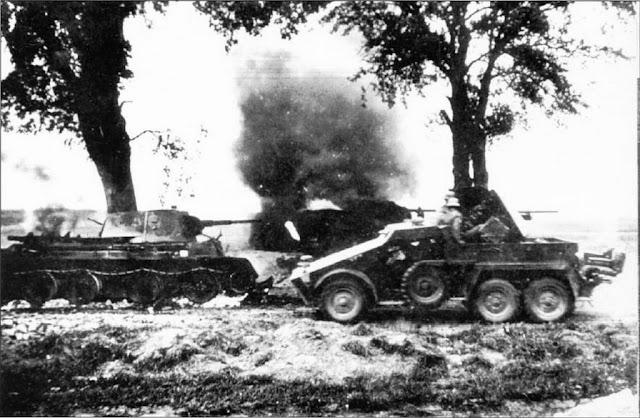 |
| Gepanzerten Krupp Protze Protzkraftwagen Portée - Kfz.69 armoured 3.7 cm Pak 36 anti-tank gun (field adaptation) in action - 1941, Ukraine. - Russian Front |
- Kfz.70 - Mannschaftskraftwagen
- Standard personnel carrier.
 |
| Krupp Protze Mannschaftskraftwagen Kfz.70 with soldiers during a parade, Germany 1937-1938. trucks in two-color cammo used during this period. |
 |
| Krupp Protze Mannschaftskraftwagen Kfz.70 with soldiers during exercises, Germany 1938-1939. Visible tactical markers are visible only during maneuvers. |
 |
| Krupp Protze L2 H143 leichter Flakkraftwagen - Kfz. 81 towing a 2 cm FlaK 30 anti-aircraft gun |
%20mit%20Fahrgestell%20des%20l.%20gl.%20Lkw.%20(o).jpg) |
| Krupp Protze L2 H143 leichter Flakkraftwagen - Kfz. 81 towing a 2 cm FlaK 38 anti-aircraft gun in the fields |
 |
| Krupp Protze L2 H143 leichter Flakkraftwagen - Kfz. 81 carrying (portée) a 2 cm FlaK 30 anti-aircraft gun |
 |
| Krupp Protze L2 H143 leichter Flakkraftwagen - Kfz. 81 carrying (portée) a MG 151/20 "Drilling" AA gun |
- Kfz.83 - leichter Scheinwerferkraftwagen I und II
- light searchlight motor vehicle
- Generator carrier for anti-aircraft searchlight, usually towed
 |
| Krupp Protze L2 H143 leichter Scheinwerferkraftwagen I - Kfz. 83 carrying a generator for AA searchlight Luftwaffe - Herman Göring Regiment - Flanders, Belgium - 1940. |
 |
| 60cm Flakscheinwerfer Gerät (Flak-Sw 36) mit Sd.Ah.51 |
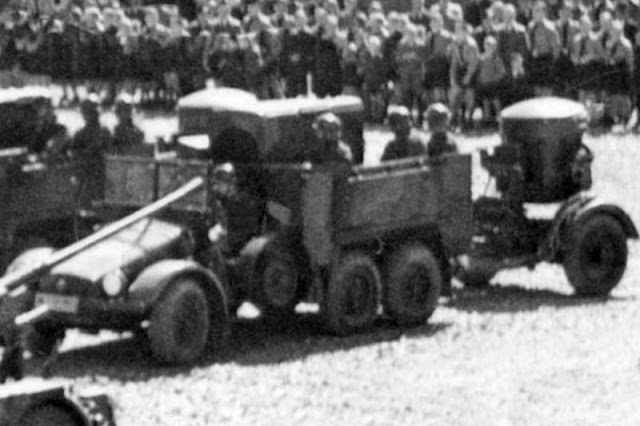 |
| Krupp Protze L2 H143 leichter Scheinwerferkraftwagen I - Kfz. 83 carrying a generator for AA searchlight and towing a 60cm Flakscheinwerfer Gerät (Flak-Sw 36) |
- Sd.Kfz. 247 Ausf. A - schwerer geländegängiger gepanzerter Personenkraftwagen (6 Rad) (Sd. Kfz. 247) mit Fahrgestell des l. gl. Lkw. (o)
- armoured personnel carrier, six-wheeled version, only 20 built in 1937; production went to Daimler-Benz, who built the Ausf. B four-wheeled version in 1941 and 1942.
 |
Sd.Kfz. 247 Ausf. A - the similarity and origin with Protz is evident ... |
Krupp Protze Funkkraftwagen (Radio Car) - Kfz 19
The Krupp Protze radio-car truck was designed as a front line communicalions vehicle. Good communications were key to the success of the Blilzkrieg War and these and other vehicles were distributed to Division and Corps commanders in the field. The Krupp Protze radio-car had a large closed "office" type body, with provision for mast or cage antennas, depending on the radio sets installed.
 |
| Krupp Protze L2 H143 Funkkraftwagen (Radio-car) - Kfz. 19 being towed in the mud... Notice the third extra wheel at the rear and the big cage antenna in the top of the vehicle. |
 |
| One unfortunate Krupp Protze L2 H143 Funkkraftwagen (Radio-car) - Kfz. 19 hit by a direct hit. Notice the carpet of logs being carried on the roof, very useful in the mud of the Russian Front. |
 |
| View of a radio operator's workstation, in the interior of a Krupp Protze L2 H143 Funkkraftwagen (Radio-car) |
 |
| Krupp Protze L2 H143 Funkkraftwagen (Radio-car) - Kfz. 19 with a motor bike, in the winter. |
These specialized vehicles allowed communication with other army units as well as with Luftwaffe control centers. The Telephone-car version - Fernsprech-Betriebskraftwagen - telephone operating motor vehicle – (Kfz. 19) mit Fahrgestell des l. gl. Lkw. (o). - was very similar, the main difference being the absence of large antennas, in relation to the radio version.
 |
| Krupp Protze L2 H143 Fernsprech-Betriebskraftwagen Kfz.19 being transported by railcar. Notice the racks for ladders in the roof |
 |
| Rear view of Krupp Protze L2 H143 Fernsprech-Betriebskraftwagen Kfz.19 It seems that the use of an extra third wheel fitted to the rear of these vehicles was popular... |
They were used on all fronts until the end of the war in 1945. The Protze began to be replaced by more fuel-efficient and cheaper-to-make trucks from early 1942 onwards, with total production of all versions was 7,000 vehicles.
Specs:
| Krupp Protze Funkkraftwagen - Kfz.19 | |
|---|---|
| Type | Radio-car |
| Place of origin | Nazi Germany |
| Service history | |
| Used by | Germany |
| Wars | World War II |
| Production history | |
| Designer | Krupp |
| Manufacturer | Krupp |
| Produced | 1934–1941 (all versions) |
| No. built | 7.000 (all versions) |
| Variants | Several, see text |
| Specifications - Kfz.19 | |
| Mass | 2.750 kg |
| Length | 5.100 mm |
| Width | 1.960 mm |
| Height Ground clearance Wading depht | 2.275 mm 225 mm 600 mm |
| Crew | 1 + 3 |
| Armor | None |
| Engine Transmission Suspensions Tyres Electric sys. | Krupp Boxer M305 3.308 cc 60 hp @ 2.500 rpm 2 speed transfer box - 6x4 front - rigid axle - leaf springs rear - independent - horiz. coil 7.50 x 17 12 volts 75 Ah |
| Payload capacity | 1.150 kg |
| Fuel capacity | 110 L |
Operational range | 450 km on road |
| Maximum speed | 70 km/h |
The kit:
For this project, I choose this kit: Bronco kit (#CB35220): German Krupp Protze Kfz.19 Radio command car:
.jpg) |
| Bronco kit (#CB35220) box art |
.jpg) |
| The box art "clean"... |
And the bald one inspecting his new task... really, Kojak loves things that are different and rare... Let's start!!!
 |
| Kojak and the new challenge.... |
The kit is very complete, with a great booklet and a good decal sheet, with some PE details. The tires are vinyl, but with good detailing... But something really caught our attention, when we opened the box:
 |
| The antenna-cage came severely bent... Ouch... thankfully it's not fractured! |
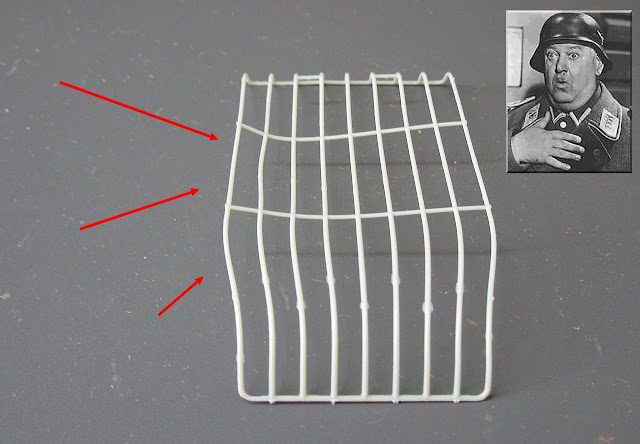 |
| Really, quite warped and twisted... |
But the remedy is simple: place the piece inside a plate, on a flat surface, place some "weights" to flatten the piece, pour boiling water over the whole set, wait a few seconds and pour ice water to promote a thermal shock in the plastic, so that it stays in the rectified position... All this done on a damp area (a kitchen sink counter, for example), because the thing gets very messy...
 |
| The weights on the piece, flattening it and the mug with boiling water from the microwave... |
 |
| And the "fixed" part, after the thermal shock. Sergeant Schultz is very happy!!!! |
 |
| After this little scare, let's continue the journey: chassis and engine, under construction... |
 |
| Fire wall, with the windshield frame and details on the chassis... The kit is very well injected and the parts fit together wonderfully... |
 |
| The Krupp boxer engine...belly view |
 |
| Starting the rear suspensions and transmission axles... |
 |
| Suspension trapezoids can be built mobile...be very careful at this stage. After the kit is lined up, I'll glue these pieces together... |
 |
| More details being glued to the chassis |
 |
| Installation of the front suspension and wheels. The alignment of the entire set is now fundamental... With this alignment carried out, I glued the rear suspension arms... Everything was perfect... |
 |
| Everything in the correct frame... Putting the wheels now interferes with the subsequent painting, but it's essential in the alignment!! |
 |
| Perfect alignment!! |
 |
| Sooo cute! |
 |
| The kit is very, very good !!! |
 |
| The girl continues to grow healthy and beautiful!!! |
 |
| Right view |
 |
| The radio table in position... |
 |
| Talking about the radio... starting the painting of the interior... |
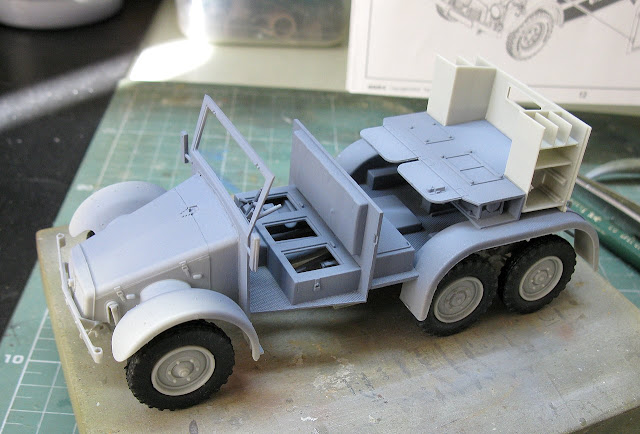 |
| The rear tools rack in position... |
 |
| Right view |
 |
| I decided to make the interior of the vehicle as light as possible. Using the cream color, like inside the Panzers... |
 |
| Panzer-grey on the structural parts and cream on the bodywork... |
 |
| Rear view |
 |
| The radio room in close-up... right view |
 |
| The radio room in close-up... left view |
The kit provides a vinyl tube, so the electrical cables can be built... But the devil is, super glue can't adhere to this infamous material. The solution was to replace the kit's vinyl tube with an electric cable (electric scrap) with the same diameter. With that, the folding and gluing of this stage of the project was solved... I love my scrap box!!!
 |
| The vinyl tube and the electric wire... I used the handle of my stiletto as a "shape" for the wire bending... |
 |
| And the electric cable in his place... Greta is celebrating!!! |
After this little scratch-job, let's continue with the construction of the interior of the vehicle...
 |
| The radio set, after painting and details... |
 |
| Radio set: rear view... |
 |
| Gluing the sides of the bodywork, previously painted in cream, inside... right view |
 |
| Closing the body...left view |
 |
| Right view |
 |
| The rear view... The girl presents a butt, shall we say... prominent... |
But going back to the Protze's interior, here are some added details that make all the difference...
 |
| Clockwise: spools of wires, propaganda poster, Morse code stick and headphone with its cables, plus a map of the theater of operations... Very well done, Greta!! |
 |
| Top view...Chin-Chin! |
 |
| The interior of the doors, in cream and with details with a little weathering... |
 |
| Closing the body... I hate doors and lids open... only the left rear tool cabinet will have the door open, with its interior visible... |
 |
| Right view |
 |
| Body details... |
 |
| Left view |
 |
| Right view |
 |
| Installing the large cage antenna... left view |
 |
| and the right view. Notice the canvas in the top of the girl's butt... |
 |
| Rear view |
 |
| Left side view |
 |
| The girl, almost ready for the painting ... |
But as the elders said "An empty mind is the Devil's workshop!!!" Me (and Kojak...) were casually looking at the pictures on the Blog and... BINGO!! Here comes stuff!!!
 |
| Notice the third spare wheels in the Protze's rear....hmmmm... |
This is the deal: I'll try to cast extra wheels, as the kit only comes with two spare wheels. The idea is to use dental alginate (irreversible hydrocolloid) to mold the wheels and reproduce them with dental acrylic. It is a quick and cheap method of reproducing parts in small quantities. As the wheels are "glued", fully facing in the trunk of the Protze, I am thinking of placing the reproduced wheels (acrylic ones) that will not present details on one of the sides, against the luggage compartment and using one of the kit wheels (fully detailed on both sides) as third wheel, on the clone wheels. But let's get to the technique. The material to be used is:
 |
| Cake recipe... |
We place the powdered alginate in the plastic vat and add water and manipulate until a homogeneous paste is formed. This mixture must be done very quickly...
 |
| Dental alginate ready for use, after mixture |
The manipulated alginate is poured into a shape and then we apply the wheel faces to be reproduced. Note that the top face will not be molded. It is this face that will be in contact with the luggage compartment...
 |
| The spare wheels in his place, in the alginate... |
I turned the mold and gently pressed the mixture against a flat surface. We waited 15 minutes for the material to completely gel.
 |
| Waiting the alginate enter into chemical gelation reaction... |
After gelling, we can remove the original parts very carefully, as alginate is much more fragile than a silicone mold, for example...
 |
| The wheels removed and the negative impressions of the wheels. Notice the little bubbles on the model (blue arrows) ... Don't worry...this will be removed later... |
Now, let's cast the new wheels. Detail: do this step immediately after removing the original wheels: the alginate mold dehydrates (and contracts...) very quickly at room temperature. If you are going to take a while to cast the new wheels, wrap the alginate mold in toilet paper moistened with water and keep it in the fridge... but never take more than 24 hours...
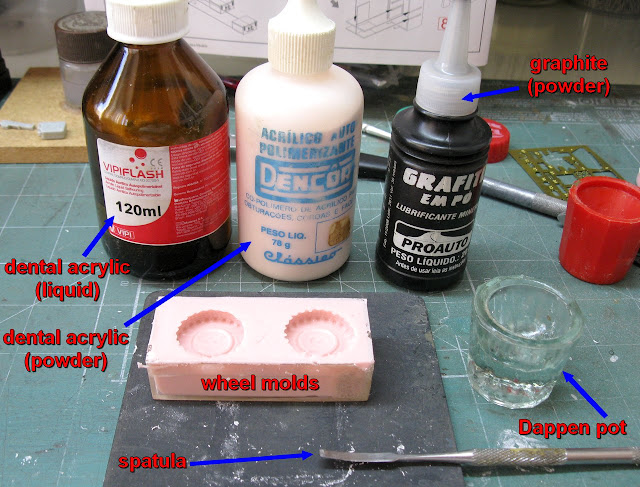 |
| Time to cast the new wheels... Here are the ingredients and materials. |
First, mix with a spatula, in a Dappen pot (or any other glass container...) the amount of 70% acrylic powder and 30% powdered graphite of what would be the total needed for the two wheels. ... The presence of graphite is to darken the substance, facilitating the identification of casting defects...
 |
| The powders separately and after mixing... |
 |
| In this powder mixture, add liquid acrylic and mix quickly until it forms a homogeneous gel, neither too liquid nor too floury... |
Then pour this gel into the negative shapes of the wheels. Be careful not to exaggerate the amount, as acrylic is extremely hard to sand or roughen, then... Work in a ventilated place, because the smell is very strong!!
 |
| Casting the new wheels!! The total cure of the material is 15 minutes... |
After 15 minutes (and an exothermic reaction...), you can remove the new wheels from the molds. if you were careful, these molds can be used one more time...then it's throw away!!!
 |
| The new wheels. Notice the bubbles (red arrows) which will be removed with the Dremel and a drill... Greta is very, very happy!!! |
 |
| After grinding with Dremel, the wheels are perfect... Hold my beer, Greta!!! |
 |
| Cheers, Greta!!! |
But continuing the construction of our radio-girl, it's painting time: a bath of primer!!!
 |
| Light grey primer... |
 |
| ... and shades of panzer-grey. Left side look at the sophisticated internal masks made with toilet paper... |
 |
| Panzer-gray in tones. right side |
 |
| Painting the girl's wheels and rear rack... left view |
 |
| Right view |
 |
| Rear view... |
Starting the detailing of the painting, with wash and dry-brush: all old (and good...) school!!
 |
| Notice the stuck-plank, on the left footboard... |
 |
| The third spare wheel, in position... left view |
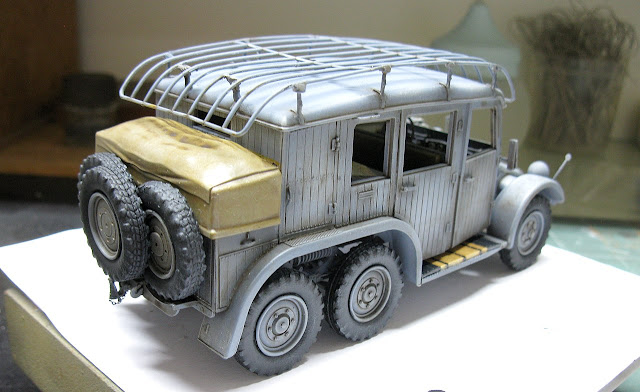 |
| The third spare wheel, in position... right view |
 |
| The girl is almost ready!!! |
And now, the best part: the markings! The Bronco kit features a good decal sheet with application instructions. But the Factory folks are pretty lazy as they cite ABSOLUTELY NOTHING about historical research of the options. In the booklet, there are only OPTION 1, 2 and 3!!! Not even the infamous phrase "Unknown Unit" they bothered to put!!
But what most aroused my curiosity were the two 4-leaf clovers (item 10) on the decal sheet... See below!
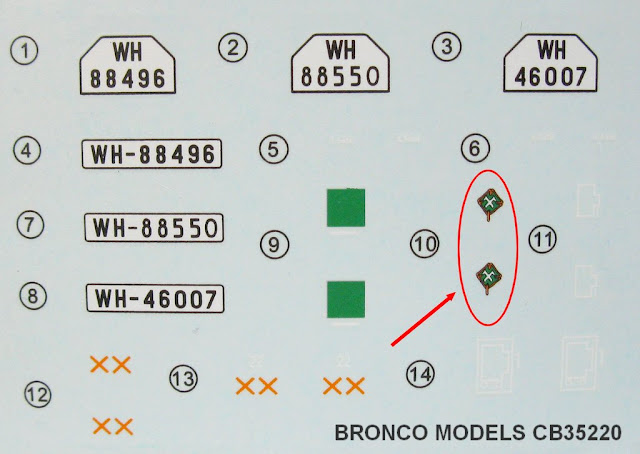 |
| Bronco's decal sheet ... |
What would the Unit be? The two yellow XX's are easy: Sixth Panzer Division, between 1941-1945!!!
But what about the 4-leaf clovers??? Well... This one took a little longer, but as the great detective Hercule Poirot said: "Nothing like using the little gray cells"...
 |
| Just want to do it!!! |
The 4-leaf clovers are the symbol of the 71st Infantry Division, just as the Tactical Symbol is that of the Motorized Radio Companies (Funkkompanie mot.).
Well... solved the problem of Historical identification, here are my appointments for our little girl: Krupp Protze L2 H143 Funkkraftwagen (Radio-car) - Kfz. 19, vehicle number 3, belonging to the 71st Infantry Division (Wehrmacht) (71. Infanterie-Division), 6th Army (Armee-Oberkommando 6), of the Army Group South (Heeresgruppe Süd), during the preparations of 1st Battle of Kiev, Ukraine, on the Russian Front, July 1941.
 |
| Markings in position - front view |
 |
| Vehicle number 3 - left side |
 |
| Vehicle number 3 - rear view |
 |
| Vehicle number 3 - right side |
 |
| A historical reference; A Horch Kfz.15 Funkwagen from 71st Infantry Division France - 1940 Notice the 4-leaf clover in the front left mudguard... |
...and with the project approaching the end, I returned to that photo of the unfortunate destroyed Protze Kfz.19, somewhere in Russia:
 |
| Hmmm...I'll try do something based in this.... |
This "carpet of logs" gave me an idea...Let's cut some Pomegranate tree (Punica granatum) branches. First, a thicker branch, to make an anti-bog log on the back of the Krupp Protze... This log was tied in place with a polyamide sewing thread (which isn't furry...), fitting the model's scale well...
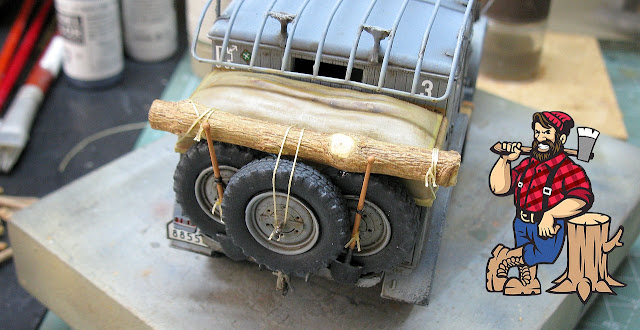 |
| The aanti-blog log in position... Notice the shovels tied together with the spare wheels... |
Now, it's time to do the carpet-log: thinner Pomegranate tree branches, cut to the same size... I'll do it differently from the photo: put the woods crosswise... I think they look nicer and help to "lift" the cage antenna, which was a little collapsed.. But first, a test-fit, to test the concept...
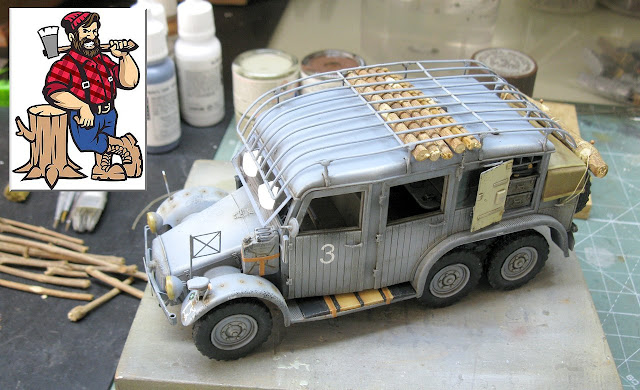 |
| Testing the size of branches...indeed, the antenna got much better!!! left view |
 |
| Carpet of logs...testing branches.. right view |
Satisfied with the concept and the size of the small branches, we will tie the "trunks" together, to form a rug: polyamide thread lacing the first trunk and with a tight and firm knot, before tying the next trunk. keep repeating this until the end, with micro-drops of superglue on the knots to prevent everything from coming undone... I stabilized the "trunk mat" with an adhesive tape, supporting the set so that the ends were free to be tied without problems...
 |
| Tying the logs with polyamide thread to make the rug... Doing a full side first... |
 |
| And repeating the process on the other side... |
 |
| And the log mat fitted in its place!!! Perfect!! left view |
 |
| Right view!!! I was very pleased with the result... |
And after a "shower" of dust and dirt (Ukraine is very dusty in summer...but its swamps are treacherous...) our girl was ready: meet Krupp Protze L2 H143 Funkkraftwagen (Radio-car) - Kfz. 19, vehicle number 3, belonging to the 71st Infantry Division (Wehrmacht) (71. Infanterie-Division), 6th Army (Armee-Oberkommando 6), of the Army Group South (Heeresgruppe Süd), during the preparations of 1st Battle of Kiev, Ukraine, on the Russian Front, July 1941.
 |
| Krupp Protze L2 H143 Funkkraftwagen (Radio-car) - Kfz. 19 vehicle number 3 - 71. Infanterie-Division - Armee-Oberkommando 6 Heeresgruppe Süd - Ukraine - Russian Front - July 1941. |
 |
| Krupp Protze L2 H143 Funkkraftwagen (Radio-car) - Kfz. 19 front left view |
 |
| Krupp Protze L2 H143 Funkkraftwagen (Radio-car) - Kfz. 19 top front left view |
 |
| Krupp Protze L2 H143 Funkkraftwagen (Radio-car) - Kfz. 19 left view |
 |
| Krupp Protze L2 H143 Funkkraftwagen (Radio-car) - Kfz. 19 top left view |
 |
| Krupp Protze L2 H143 Funkkraftwagen (Radio-car) - Kfz. 19 rear left view |
 |
| Krupp Protze L2 H143 Funkkraftwagen (Radio-car) - Kfz. 19 left tool cabinet details |
 |
| Krupp Protze L2 H143 Funkkraftwagen (Radio-car) - Kfz. 19 internal details |
 |
| Krupp Protze L2 H143 Funkkraftwagen (Radio-car) - Kfz. 19 rear right view |
 |
| Krupp Protze L2 H143 Funkkraftwagen (Radio-car) - Kfz. 19 right view |
 |
| Krupp Protze L2 H143 Funkkraftwagen (Radio-car) - Kfz. 19 top right view |
 |
| Krupp Protze L2 H143 Funkkraftwagen (Radio-car) - Kfz. 19 front right view |
 |
| Krupp Protze L2 H143 Funkkraftwagen (Radio-car) - Kfz. 19 with Kojak and Rover, the dog. |
 |
| Krupp Protze L2 H143 Funkkraftwagen (Radio-car) - Kfz. 19 with Panzer I Ausf.B Command car |
 |
| Krupp Protze L2 H143 Funkkraftwagen (Radio-car) - Kfz. 19 vehicle number 3 - 71. Infanterie-Division - Armee-Oberkommando 6 Heeresgruppe Süd - Ukraine - Russian Front - July 1941. |
Thanks for following along, Kameraden!
The Radio-car is ready!!











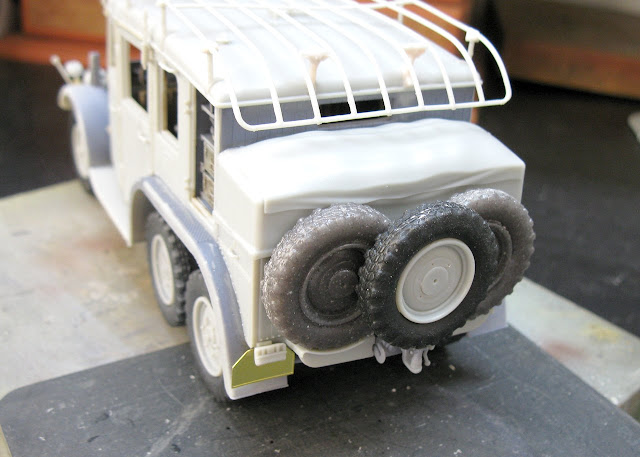






Marcos, as always excellent, a beautiful German vehicle.
ResponderExcluirHola, Jose... Thanks, my friend!!! Stay with us, because more good things are coming!!!
ExcluirShow, o que mais me impressiona é todo o seu trabalho de pesquisa pra fazer uma miniatura tão bem detalhada.
ResponderExcluirOi Marcão!! Que bom te rever por aqui... Para mim, a pesquisa histórica é tão gostosa quanto construir o modelo... Um abração, Xará!!! Se cuida!!!
ExcluirBeautiful work i like it
ResponderExcluirThanks, Anonimous!!! I'm glad you liked it... come back here often...
ExcluirWow, beautiful build!
ResponderExcluirThanks a lot!!! Hugs!!!
ExcluirGreat work compliment!!!
ResponderExcluirThanks a lot, my anonimous friend!!!
ExcluirGreat work.
ResponderExcluirThanks a lot, man!!
Excluir